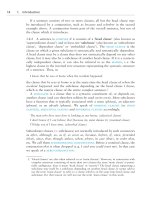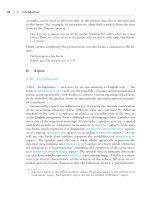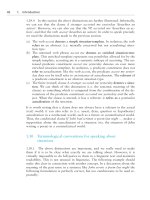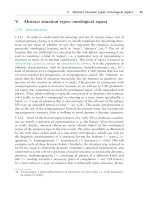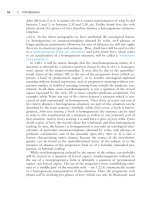The grammar of the english verb phrase part 100 ppt
Bạn đang xem bản rút gọn của tài liệu. Xem và tải ngay bản đầy đủ của tài liệu tại đây (122.26 KB, 7 trang )
686 14. Adverbial before-clauses and after-clauses
Abstract
This chapter deals with the use of tenses in sen-
tences consisting of a head clause and an adver-
bial time clause if the latter is introduced by be-
fore or after. Until-clauses are also included in
the discussion.
Part I deals with before-clauses. We begin by
explaining the temporal structure of before,
which is interpreted as ‘before the time at
which’. The implicit orientation time lexicalized
as the time in this paraphrase is called the ‘An-
chor time’. The before-clause establishes a dura-
tive Adv-time which contains the situation time
of the head clause, or another orientation time
from the tense structure of the head clause, in
terms of inclusion or coincidence. The situation
time of the before-clause can function as Anchor
time or is T-related to the Anchor time by a rela-
tive tense form.
In section B of part I, we investigate the
tenses that can be used in the head clause and
the before-clause if the latter functions as a situ-
ation-time adverbial (i. e. if the situation time of
the head clause is the orientation time that is
contained in the Adv-time denoted by the be-
fore-clause). We come to the conclusion that
there are several possible temporal configura-
tions, the most important of which are il-
lustrated by John left before Bill arrived (which
represents both situations as past facts), John
had left before Bill arrived (where the head
clause receives a resultative reading) and John
left before Bill had arrived (where the past per-
fect underscores the ‘not-yet-factual-at-t’ read-
ing of the before-clause, i. e. the idea that Bill
had not (yet) arrived when John left).
In section C of part I, we examine the excep-
tional cases in which a before-clause functions
as an orientation-time adverbial.
Section D of part I is concerned with the vari-
ous factors (including the choice of tense) which
can induce the before-clause to be interpreted as
factual (as in John left before Bill arrived),
counterfactual (as in John died two weeks be-
fore he would have celebrated his 30
th
birthday)
or not-yet-factual-at-t (as in John left before Bill
had arrived).
In section E of part I, a comparison is made
between before-clauses and until-clauses.
Part II is devoted to after-clauses. We start by
examining the temporal structure of after, which
is interpreted as ‘after the time at which’. The
implicit orientation time lexicalized as the time
in this paraphrase is called the ‘Anchor time’.
The after-clause establishes a durative Adv-time
which contains the situation time of the head
clause, or another orientation time from the
tense structure of the head clause, in terms of
inclusion or coincidence. The situation time of
the after-clause can function as Anchor time or
is T-related to the Anchor time by a relative
tense form.
In the rest of Part II, the possible tense config-
urations are examined which can be realized in
a sentence consisting of a head clause and an
after-clause.
In Part III, the main findings of this chapter
are summarized.
I. Adverbial
before
-clauses 687
I. Adverbial
before
-clauses
A. Introduction
14.1 Terminology
The terminology that will be used here is largely the same as has been used in
the discussion of adverbial when-clauses in chapter 13. The superordinate
clause on which an adverbial before-clause syntactically depends will be called
the
head clause. We will call the time of the (‘predicated’ Ϫ see 2.12.1) situa-
tion referred to in the head clause the
situation time of the head clause.
We will similarly speak of the
situation time of the
before
-clause.The
function of an adverbial before-clause, and in fact of any time-specifying adver-
bial, is to create an
Adv-time, i. e. to specify a (punctual or durative) interval
which contains (in terms of inclusion or coincidence Ϫ see 2.23.1) either the
situation time of the head clause (in which case the before-clause is a
situa-
tion-time adverbial
Ϫ see 2.24) or another orientation time to which the
situation time of the head clause is related by the tense form of the head clause
(in which case the before-clause functions as an
orientation-time adver-
bial
Ϫ see 2.25). The orientation time (from the tense structure of the head
clause) that is contained by the Adv-time will be called the
contained orien-
tation time
.
14.2 The temporal structure of before
The temporal structure of the conjunction before is shown in Figure 14.1.
14.2.1 The conjunction before is semantically equivalent to ‘before the time
{that / at which}’. This is in keeping with the fact that the conjunction before
has actually developed from a phrase of the form ‘before the time that’ or
‘before then that’ (variously realized in Old English as toforan ¤am timan ¤e,
foran to ¤am timan ¤e and toforan ¤am ¤e). The sentence John left before Bill
arrived can therefore be paraphrased ‘John left at a time before the time
{when / at which} John arrived’.
1
In this paraphrase, a time before … refers
to the Adv-time, at expresses the containment relation between this Adv-time
1. Since there is no semantic difference between ‘X actualized before the time that Y actual-
ized’ and (the more unwieldy) ‘X actualized at a time before the time that Y actualized’,
we treat the latter as a valid paraphrase of the former.
688 14. Adverbial before-clauses and after-clauses
and the contained orientation time, and the second time refers to the terminal
point of the Adv-time. Let us refer to the latter point as the ‘
Anchor time’of
the before-clause. The temporal structure of the conjunction before can be
represented as in Figure 14.1. (Remember that the contained orientation time
is represented by an x irrespective of whether it is included in the Adv-time or
coincides with it.)
Figure 14.1. Representation of the temporal structure of before.
14.2.2 As is clear from Figure 14.1, the conjunction before establishes a dura-
tive Adv-time whose right boundary is an Anchor time (lexicalized as the time
in the paraphrase ‘before the time that’). The Adv-time contains the contained
orientation time (in terms of inclusion or coincidence). If there is inclusion,
before means ‘at some time in the course of the period before’; if there is
coincidence, before means ‘throughout the period before’. As we will see, the
Anchor time may be either the situation time of the before-clause itself or
another (implicit) orientation time to which the situation time of the before-
clause is T-related. By contrast, the contained orientation time is nearly always
the situation time of the head clause itself. (In this respect, before-clauses differ
from when-clauses, which are more easily used as orientation-time adverbials.)
For example:
John left before Bill arrived. (The situation time of the head clause, i. e. the time of
John’s leaving, is the contained orientation time, while the situation time of the
before-clause is the Anchor time.)
John will leave before Bill arrives. (The situation time of the head clause is the
contained orientation time, while the situation time of the before-clause is repre-
sented as T-simultaneous with the implicit Anchor time.)
14.3 Temporal structures involving a head clause and a
before-clause
14.3.1 It follows from the previous section that at least the following two
temporal structures involving a head clause and a before-clause are possible.
In both cases the before-clause functions as a situation-time adverbial.
I. Adverbial
before
-clauses 689
(a) Firstly, the situation time of the head clause may be contained in the Adv-
time, while the situation time of the before-clause is T-related to an implicit
Anchor time (by a relative tense form):
John will leave before the pub closes. (The situation time of the head clause is
included in the Adv-time. The before-clause uses a ‘Pseudo-t
0
-System form’ Ϫ see
10.2 Ϫ to T-relate the situation time of the before-clause to the implicit Anchor
time. The temporal structure of the sentence is shown in Figure 14.2.)
[I hoped that] the convict would be treated well before he was executed. (The
situation time of the head clause coincides with the Adv-time. The before-clause
uses the relative past Ϫ see 8.12 Ϫ to represent the situation time of the before-
clause as T-simultaneous with the Anchor time. Because the past tense in the be-
fore-clause is not an absolute preterite, the situation referred to is not interpreted
as t
0
-factual Ϫ see 14.4.2 below.)
He left long before I had arrived. (The situation time of the head clause is included
in the Adv-time. The before-clause uses the past perfect to represent its situation
time as T-anterior to the implicit Anchor time.)
John will leave before the pub closes. (The situation time of the head clause is
included in the Adv-time. The situation time of the before-clause is represented as
T-simultaneous with the Anchor time.)
[I expected that] he would leave before the pub closed. (The situation time of the
head clause is the contained orientation time. The before-clause uses a ‘relative
past tense’ to represent the situation time of the before-clause as T-simultaneous
with the implicit Anchor time.)
John would leave before the pub had closed. (The situation time of the head clause
is the contained orientation time. The situation time of the before-clause is repre-
sented as T-anterior to the implicit Anchor time.)
Figure 14.2. The temporal structure of John will leave before the pub closes.
In the above examples, the before-clause each time functions as a situation-
time adverbial, i. e. it specifies an Adv-time which includes the situation time of
the head clause. The situation time of the before-clause is each time temporally
subordinated to (ϭ bound by) the Anchor time by means of a relative tense.
690 14. Adverbial before-clauses and after-clauses
(As to the head clause, it uses either an absolute or a relative tense form. This
is not relevant to the present discussion.)
(b) Secondly, the situation time of the head clause may be contained in the
Adv-time (which therefore functions as a situation-time adverbial), while
the situation time of the before-clause is the Anchor time. (This possibility
corresponds exactly to the temporal structure presented in Figure 14.1.)
For example:
The man killed his wife and children before he shot himself. (The situation time
of the head clause is included in the Adv-time. The situation time of the before-
clause is the Anchor time, i. e. the terminal point of the Adv-time.)
He was a well respected citizen before he killed his wife. (Similar, except that the
situation time of the head clause now coincides with the Adv-time. This is another
form of ‘being contained’ in the Adv-time.)
John had left before the pub closed.
14.3.2 There are also cases in which the before-clause functions as an orienta-
tion-time adverbial (i. e. the contained orientation time is not the situation time
of the head clause but an implicit orientation time binding the situation time
of the head clause). The following (not very likely) example illustrates nicely
how the temporal structure may then look like:
(1) [If the National Health Service is dismantled further] some people will be about
to die before they get medical treatment.
This sentence realizes the structure represented by Figure 14.3.
Figure 14.3. The temporal structure of Some people will be about to die before they
get medical treatment.
I. Adverbial
before
-clauses 691
Sentence (1) can be paraphrased as follows:
(1Ј) In the period before the time when (ϭ at which) they get medical treatment, it
will be the case that some people are about to die.
Paraphrase (1Ј) reveals the various temporal relations:
(a) The time referred to by it will be the case is the contained orientation time
of the head clause.
(b) In the period indicates this containment relation.
(c) Before expresses that the Adv-time is a time span that lies before (i. e.
leads up to) an Anchor time. (This ‘before’ relation is expressed by the
conjunction, not by either of the tense forms.)
(d) The Anchor time is indicated by the second occurrence of the time in (1Ј).
It remains implicit in (1).
(e) The situation time of the before-clause is bound by the Anchor time in
terms of T-simultaneity: the Pseudo-t
0
-System form get is used for this.
(f) The string it will be the case that some people are about to die in the
paraphrase reflects the fact that the verb form of the head clause of (1)
(will be about to die) is an absolute-relative tense form: it both establishes
a post-present domain and expresses posteriority in it:
2
the situation time
of the head clause (i. e. the time of people dying) is represented as T-
posterior to the implicit contained orientation time (which coincides with
the Anchor time and is the central orientation time of a post-present do-
main).
(g) The situation time of the head clause and the situation time of the before-
clause are bound by different orientation times, which are the (implicit)
‘central orientation times’ (see 8.15) of two different post-present domains:
the situation time of the head clause is bound by the implicit contained
orientation time of the head clause, while the situation time of the before-
clause is bound by the Anchor time.
The temporal structure of (1) is rather intricate, but in later sections we will
discuss sentences like the following, whose temporal structures are equally, if
not more, complex:
Before they had gone very far, Jill had already sprained her ankle.
Mother will have gone to bed before I have finished my homework.
2. Be about to can be used as a ‘futurish’ form expressing posteriority Ϫ see 2.9.1.
692 14. Adverbial before-clauses and after-clauses
14.4 The nature of past tense forms in before-clauses
The situation time of the before-clause may be T-related to the Anchor time (ϭ the
terminal point of the Adv-time, lexicalized as the time in the paraphrase ‘before the
time that’) or may be the Anchor time itself. In the former case the before-clause uses
a relative tense form, in the latter it uses an absolute tense form. This section provides
evidence for this claim.
In one of the arguments it is noted that before-clauses are ‘factual at t
0
’ (or ‘t
0
-
factual’) if they represent their situation as actualizing in the past (e. g. John left before
Bill arrived). However, when the before-clause forms part of an opaque (intensional)
context, it is interpreted as ‘not-yet-factual at the binding time’ (or ‘not-yet-factual at
t’), i. e. as not yet a fact at the time of the situation time of the head clause (e. g. John
wanted to leave before Bill arrived).
14.4.1 In section 14.3.1 we have stated that the situation time of the before-
clause may be T-related to the Anchor time (ϭ the terminal point of the Adv-
time, lexicalized as the time in the paraphrase ‘before the time that’) or may
be the Anchor time itself. In the former case the before-clause uses a relative
tense form, in the latter it uses an absolute tense form.
The claim that a before-clause can use a relative tense form is confirmed by
examples like the following:
I will switch off the lights before I {leave /*will leave} the house. (Pseudo-t
0
-System
form expressing T-simultaneity with the Anchor time)
[I hoped that] he would switch off the lights before he {left /*would leave} the
house. (Left is a relative past tense form expressing T-simultaneity with the Anchor
time; would leave, which would effect ‘indirect binding’, is not grammatical.)
At first sight it would not seem to be as easy to prove the claim that a before-
clause can also use an absolute tense, because (for reasons explained in 10.7.2)
an adverbial before-clause cannot normally use an Absolute Future System
form:
He will leave before the pub {*will close / closes}.
However, there are some exceptions Ϫ see 14.5.2 below:
It will be a long time before that {will become / becomes} possible.
I think those creating tablet PCs need a “killer app” to run on these units before
they will be useful. (www)
[Safe housing near campus is limited.] The best housing is reserved by local students
weeks before you will arrive. (www)
Tell Steve hello for him! He will be seeing Steve again before I will on June 5th The
Crossroads Guitar Festival. (www)



